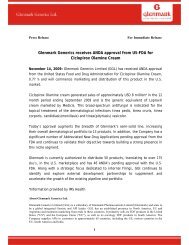Annual Report - Glenmark
Annual Report - Glenmark
Annual Report - Glenmark
Create successful ePaper yourself
Turn your PDF publications into a flip-book with our unique Google optimized e-Paper software.
<strong>Glenmark</strong> Pharmaceuticals Limited<br />
Figures in Rs. /Mn.<br />
Head March 2005 March 2004<br />
Creditors 556.23 464.60<br />
Other Liabilities 130.52 192.29<br />
Dividend and Dividend Tax 94.68 88.23<br />
781.43 745.12<br />
Net Working Capital<br />
The net working capital has increased<br />
from Rs. 1841.53 million to Rs. 5114.87<br />
million due to an increase in the<br />
receivables by Rs. 516.23 million, cash<br />
and bank balance by Rs. 1025.10 million,<br />
and loans and advances by Rs. 1479.33<br />
million.<br />
Opportunities<br />
Low per capita expenditure on<br />
pharmaceuticals<br />
India has one of the lowest per capita<br />
health care expenditures in the world,<br />
which is likely to correct over the<br />
coming years. For instance, India's per<br />
capita expenditure on pharmaceuticals<br />
is only USD 4, well below USA [USD<br />
1992], Canada [USD 1483], Germany<br />
[USD 1819] and United Kingdom [USD<br />
1415].<br />
Privatisation of insurance<br />
Presently, only two million Indians - 0.2<br />
percent of the population - are<br />
medically insured even as a recent study<br />
indicates that 75 percent are potentially<br />
insurable. Insurance companies have<br />
estimated that household healthcare<br />
spending will rise from 2 per cent to 6<br />
percent in the coming years, translating<br />
into attractive growth for India's<br />
pharmaceutical industry.<br />
Rising income levels<br />
Rising incomes and an increase in the<br />
geriatric population, sustained by<br />
advances in hygiene and medicine, are<br />
driving a shift in the market away from<br />
vitamins, anti-infectives and<br />
gastrointestinal treatments towards<br />
products that treat cardiovascular<br />
problems, central nervous system<br />
disorders, diabetes and other complex<br />
ailments. By 2010, cardiovascular and<br />
central nervous system treatments will<br />
account for a higher share of remedies<br />
provided. This is expected to result in a<br />
faster growth for companies like<br />
<strong>Glenmark</strong> that specialise in related<br />
niches.<br />
Rural opportunity<br />
Presently, 76 percent of the Indian<br />
pharmaceutical off-take transpires in<br />
urban centres. The four metros namely<br />
Delhi, Mumbai, Kolkata and Chennai<br />
account for about a fourth of the entire<br />
IPM. Within rural India, the market is<br />
concentrated in areas where the level of<br />
infrastructure development is relatively<br />
high. According to the World<br />
Development <strong>Report</strong> 2000, only 50<br />
percent of the population in India has<br />
access to healthcare facilities. In rural<br />
areas, this percentage is lower. As<br />
penetration levels improve, a broader<br />
growth for India's pharmaceutical<br />
industry is expected.<br />
Generics opportunity<br />
This has been discussed in detail earlier.<br />
Threats<br />
The implementation of GATT from 2005<br />
represents the biggest threat facing the<br />
IPI. India will recognise product patents,<br />
thus reducing process reverse<br />
engineering opportunities. Indian<br />
companies that have not prepared for<br />
this reality will face intense competition<br />
and perhaps even de-grow over the<br />
coming years.<br />
Outlook<br />
<strong>Glenmark</strong>'s short-term and long-term<br />
outlook appears encouraging for the<br />
following reasons:<br />
An integrated approach with a<br />
presence in R&D, bulk actives and<br />
formulations along with an increasing<br />
coverage of markets with its own sales<br />
force.<br />
A strong focus on establishing each<br />
element in its integrated chain as a<br />
revenue generator.<br />
A commitment to expand to new<br />
global markets with customised<br />
strategies.<br />
A horizontal and vertical expansion in<br />
therapeutic segments in all target<br />
markets.<br />
A reputation for being a first-mover in<br />
target markets and launching drugs in<br />
different therapeutic segments with low<br />
cycle times.<br />
An aggressive and adaptable<br />
marketing approach to widen its doctor<br />
reach, e.g. creation of 8 new divisions,<br />
each having its own marketing focus.<br />
A variety of investments ranging from<br />
upgrading manufacturing capabilities,<br />
understanding regulatory requirements,<br />
alliances, and building IPR assets, like<br />
new drugs and delivery systems for the<br />
future.<br />
Human Resources<br />
Development<br />
The successes and rate of expansion<br />
seen by <strong>Glenmark</strong> have raised unique<br />
challenges for the human resources (HR)<br />
function. The main among these are:<br />
Management of sourcing processes in<br />
countries of operation and the<br />
assimilation of the diverse work-force<br />
into a <strong>Glenmark</strong> work ethic. Additionally,<br />
the development of processes and<br />
systems that cater to a global audience.<br />
Continually adding to the skill<br />
inventory of the organization to help<br />
fuel its growth and value addition to<br />
41<br />
<strong>Annual</strong> <strong>Report</strong> 2004-2005



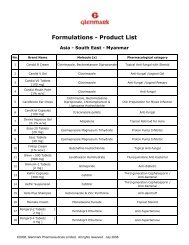


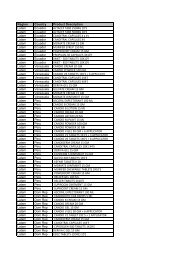
![Formulations [India] â Product List - Glenmark](https://img.yumpu.com/46601329/1/190x245/formulations-india-a-product-list-glenmark.jpg?quality=85)
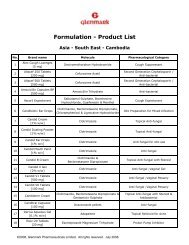
![Formulation [India] â Product List - Glenmark](https://img.yumpu.com/44013338/1/190x245/formulation-india-a-product-list-glenmark.jpg?quality=85)


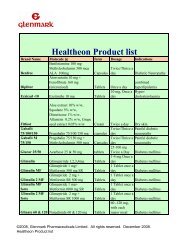
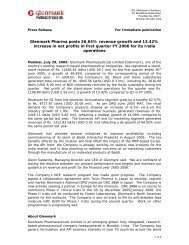
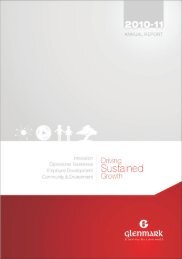
![Formulations [India] â Product List - Glenmark](https://img.yumpu.com/35994839/1/190x245/formulations-india-a-product-list-glenmark.jpg?quality=85)
